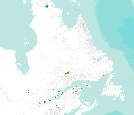Filters: Tags: landscape (X) > partyWithName: Conservation Biology Institute (X)
82 results (11ms)|
Filters
Date Range
Extensions Types Contacts
Categories Tag Types
|

This dataset represents presence of Jack Pine (Pinus banksiana) in Minnesota (USA) at year 50 (2045) from a single model run of LANDIS-II. The simulation assumed Intergovernmental Panel on Climate Change (IPCC) B2 emissions (moderate) and used the Hadley 3 global circulation model. Restoration harvest rates and intensities were simulated.

This dataset represents presence of Sugar Maple (Acer saccharum) in Minnesota (USA) at year 0 (2145) from a single model run of LANDIS-II. The simulation assumed Intergovernmental Panel on Climate Change (IPCC) B2 emissions (moderate) and used the Hadley 3 global circulation model. Contemporary harvest rates and intensities were simulated.

This dataset displays the boundaries of Intact Forest Landscapes for the Kenai region of the state of Alaska. Intact Forest Landscapes are defined as areas at least 50,000 hectares that are absent of human disturbance visible on satellite imagery (e.g., roads, logging, mining, settlement). For more information, see the full report, available on the Global Forest Watch website (www.globalforestwatch.org), or the Conservation Biology Institute website (http://www.consbio.org/cbi/projects/show.php?page=alaska);.

The datatset is a compilation of all permanent (legally established) protected areas in Ontario, Canada.

The datatset is a compilation of all permanent (legally established) protected areas in Nunavut, Canada.

This dataset represents presence of white pine (Pinus strobus) at year 100 (2095) from a single model run of LANDIS-II. The simulation assumed Intergovernmental Panel on Climate Change (IPCC) B2 emissions (moderate) and used the Hadley 3 global circulation model. Contemporary harvest rates and intensities were simulated.

This map layer is extracted from a grid map of North America including the Caribbean and most of Mexico. The map layer is an excerpt from a global assessment of forest fragmentation (Riitters et al., 2000). Each pixel value represents an index of forest fragmentation for the surrounding 81 sq. km. The map layer was created by applying spatial algorithms to a 1 sq. km. resolution map of global land cover (Loveland and Belward 1997) known as NAIGBP1_2L, obtained from the USGS Center for EROS Distributed Active Archive Center (DAAC) as part of the Global Land Cover Characteristics database (GLCC)(Loveland et al. 1991, 1999). One of six categories of fragmentation was identified for each forested pixel in North...

The datatset is a compilation of all permanent (legally established) protected areas in Quebec, Canada.

This dataset represents presence of Black Spruce (Picea mariana) at year 100 (2095) from a single model run of LANDIS-II. The simulation assumed Intergovernmental Panel on Climate Change (IPCC) B2 emissions (moderate) and used the Hadley 3 global circulation model. Contemporary harvest rates and intensities were simulated.

This dataset represents presence of Red Pine (Pinus resinosa) at year 50 (2045) in Minnesota (USA) from a single model run of LANDIS-II. The simulation assumed Intergovernmental Panel on Climate Change (IPCC) B2 emissions (moderate) and used the Hadley 3 global circulation model. Contemporary harvest rates and intensities were simulated.

This dataset represents presence of Red Pine (Pinus resinosa) at year 0 (1995) in Minnesota (USA) from a single model run of LANDIS-II. The simulation assumed Intergovernmental Panel on Climate Change (IPCC) B2 emissions (moderate) and used the Hadley 3 global circulation model. Restoration harvest rates and intensities were simulated.

This dataset represents presence of Black Spruce (Picea mariana) at year 150 (2145) from a single model run of LANDIS-II. The simulation assumed Intergovernmental Panel on Climate Change (IPCC) B2 emissions (moderate) and used the Hadley 3 global circulation model. Restoration harvest rates and intensities were simulated.

This dataset represents presence of Sugar Maple (Acer saccharum) at year 100 (2095) from a single model run of LANDIS-II. The simulation assumed Intergovernmental Panel on Climate Change (IPCC) B2 emissions (moderate) and used the Hadley 3 global circulation model. Restoration harvest rates and intensities were simulated.

This dataset depicts dominant species groups in Minnesota (USA) at year 0 (1995) from a single model run of LANDIS-II. The simulation assumed Intergovernmental Panel on Climate Change (IPCC) A2 emissions (moderate) and used the Hadley 3 global circulation model. Restoration harvest rates and intensities were simulated. Restoration harvesting was spatially allocated following ecological land units (rather than ownership) and harvest frequency, severity, and size distributions were based on historic wind and fire regimes. The projected dominant species were listed as follows: 1) Spruce and Fir; 2) Northern Hardwoods: Sugar Maple; 3) Northern Hardwoods: Red Maple; 4) Aspen and Birch; 5) White, Red, and Jack Pine; 6)...

The datatset is a compilation of all permanent (legally established) protected areas in Northwest Territories, Canada.

This dataset represents presence of Red Pine (Pinus resinosa) at year 100 (2095) in Minnesota (USA) from a single model run of LANDIS-II. The simulation assumed Intergovernmental Panel on Climate Change (IPCC) B2 emissions (moderate) and used the Hadley 3 global circulation model. Contemporary harvest rates and intensities were simulated.

This dataset represents presence of Sugar Maple (Acer saccharum) in Minnesota (USA) at year 100 (2095) from a single model run of LANDIS-II. The simulation assumed Intergovernmental Panel on Climate Change (IPCC) B2 emissions (moderate) and used the Hadley 3 global circulation model. Contemporary harvest rates and intensities were simulated.

The datatset is a compilation of all permanent (legally established) protected areas in New Brunswick, Canada.

Forest Management Units are one of several GeoAdministrative layers maintained within the Base Feature dataset. GeoAdministrative boundaries are land areas that have explicitly defined boundaries, established by legislation or by an agency to manage or administer land use.

This dataset represents presence of Red Pine (Pinus resinosa) at year 150 (2145) in Minnesota (USA) from a single model run of LANDIS-II. The simulation assumed Intergovernmental Panel on Climate Change (IPCC) B2 emissions (moderate) and used the Hadley 3 global circulation model. Contemporary harvest rates and intensities were simulated.
|

|